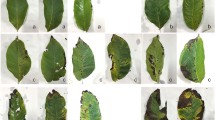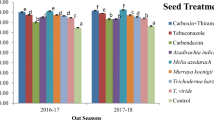Abstract
Walnut blight (WB), caused by the bacterium Xanthomonas arboricola pv. juglandis,continues to be a serious disease of walnut in northern China, where weather conditions favor disease development. From 2013 to 2017, WB incidences in walnut cv. ‘Liaoning 1’ were investigated in three areas (Dalian,Suizhong and Jianchang areas) in the Liaoning province, northeastern China. WB incidence was high in Dalian (23.72%) and Suizhong (24.31%) but was low in Jianchang (12.98%). Relative humidity is a key meteorological factor that affected the differences between areas. Ten walnut cultivars were surveyed in 2013, 2015, and 2017 for their susceptibility to blight. Lateral-bearing walnut cultivars showed a higher incidence and were found more susceptible to WB compared with terminal-bearing cultivars. In order to test the most effective chemical spray methods, bactericide screening trials were conducted comprising 12 different types of bactericides and mixtures in 2015. The combination of kasugamycin+mancozeb was most effective in controlling WB incidence resulting in lowest fruit disease incidence (2.63%). Subsequently, minimal spray trials were studied to determine the most effective chemical control as well as timing and frequency of application in 2017. The study confirmed these results of studies done in California: the best timing for the first spray application was at 30%–40% pistillate flower emergence and subsequently spray times were at 6 days and 16 days interval. Results of this study provide essential information to better understand the complexity of this walnut disease toward developing effective control management strategies globally.





Similar content being viewed by others
References
Adaskaveg, J.E., Förster, H., Thompson, D., Enns, J., Buchner, R.P. (2010). Epidemiology and management of Walnut Blight. Walnut Research Reports 2009 California Walnut Marketing Board, 195–213. http://walnutresearch.ucdavis.edu/2010/2010_195.pdf
Arquero, O., Lovera, M., & Trapero, A. (2005). Walnut blight (Xanthomonas arboricola pv. Juglandis): factors influencing disease incidence. Acta Horticulturae, 705, 443–446. https://doi.org/10.17660/ActaHortic.2005.705.64.
Bangemann, L., Westphal, A., Zwerger, P., Sieling, K., & Kage, H. (2014). Copper reducing strategies for late blight (Phytophthora infestans) control in organic potato (Solanum tuberosum) production. Journal of Plant Diseases and Protection, 121, 105–116. https://doi.org/10.1007/BF03356498.
Baojun, Z., Feng, L., Yonghong, G., & Dongsheng, L. (2020). ‘Liaoning 1’ walnut cultivar. HortScience, 55(3), 392–394. https://doi.org/10.21273/HORTSCI14801-19.
Belisario, A., & Zoina, A. (1995). Occurrence of Persian (English) walnut blight and its control in the nursery. European Journal of Forest Pathology, 25, 224–231.
Bell, C. J. (2014). A comparison of blight infection rates in four walnut cultivars as affected by spray treatment and environment. Acta Horticulturae, 1050, 315–321. https://doi.org/10.17660/ActaHortic.2014.1050.43.
Buchner, R. P., Olson, W. H., Adaskaveg, J. E., Lindow, S. E., & Koutsoukis, R. (2010). Spray timing and material for walnut blight (Xanthomonas campestris pv.juglandis,Xanthomonas arboricola pv juglandis) control in northern California USA. Acta Horticulturae, 861, 457–463. https://doi.org/10.17660/ActaHortic.2010.861.65.
Buchner, R.P., Gilles, C., Olson, W.H., & Adaskaveg, J.E. (2014). Walnut blight Management Using Xanthomonas arboricola pv. Juglandis Dormant bud Population Sampling. Proceedings of the 7th Intern. Walnut Symposium, Acta Hortic 1050, 331–338.https://doi.org/10.17660/ActaHortic.2014.1050.45.
Chevallier, A., Bray, O., Prunet, J. P., & Giraud, M. (2010). Factors influencing walnut blight symptoms emergence and development. Acta Horticulturae, 861, 473–478. https://doi.org/10.17660/ActaHortic.2010.861.67.
Fan, K., Fu, L., Wu, H. B., Gong, Y., Liu, J. G., & Qu, J. L. (2020). Investigation on the occurrence and harm of walnut blight in Shandong province (in Chinese). Deciduous Fruits, (03), 24–26. https://doi.org/10.13855/j.cnki.lygs.2020.03.014.
Gong, Y. H. (2012). Advance in research on walnut blight (in Chinese). Northern Fruits, (06), 1–4. https://doi.org/10.16376/j.cnki.bfgs.2012.06.011.
Hassani, D., Sarikhani, S., Dastjerdi, R., Mahmoudi, R., Soleimani, A., & Vahdati, K. (2020). Situation and recent trends on cultivation and breeding of Persian walnut in Iran. Scientia Horticulturae, 270, 109369. https://doi.org/10.1016/j.scienta.2020.109369.
Jenkins, T. A., Marsh, C., Lang, M. D., Vanestre, J., Walter, M., & Obanor, F. (2010). Walnut blight sustainable management research in New Zealand. Acta Horticulturae, 861, 479–488. https://doi.org/10.17660/ActaHortic.2010.861.68.
Jiang, S.J. (2019). Sensitivity evaluation and disease resistance mechanism to walnut blight(in Chinese). Doctoral dissertation. Sichuan Agriculture University. .
Jiang, S. J., Han, S., He, D., Cao, G. L., Zhang, F., & Wan, X. Q. (2019). Evaluating walnut (Juglans spp.) for resistance to walnut blight and comparisons between artificial inoculation assays and field studies. Australasian Plant Pathology, 48, 221–231. https://doi.org/10.1007/s13313-019-0621-0.
Lang, M. D., Evans, K. J., & Pethybridge, S. J. (2010). Timing bactericides strategically for management of walnut blight in Tasmania, Australia. Acta Horticulturae, (861), 465–472. https://doi.org/10.17660/ActaHortic.2010.861.66.
Lindow, S. E., Olson, W., & Buchner, R. P. (2014). Colonization of dormant walnut buds by Xanthomonas arboricola pv. juglandis is predictive of subsequent disease. Phytopathology, 104, 1163–1174.
Ramos, D.E. (1998). Bark, fruit, and foliage disease. In: Walnut Production Manual. Division of agriculture and natural resources, University of California: 242–246.
Scotton, M., Bortolin, E., Fiorin, A., & Belisario, A. (2015). Environmental and pathogenic factors inducing brown apical necrosis on fruit of English (Persian) walnut. Phytopathology, 105, 1427–1436. https://doi.org/10.1094/PHYTO-01-15-0029-R.
Shi, A. X., Zhi, X. M., Wang, C. X., & Zhao, X. L. (2010). Causes of walnut blight and comprehensive control measure s(in Chinese). Northwest Horticulture, (02), 26–27.
Wang, G. A., Shang, X. Y., Zhang, Q., Abduxukur, Y., & Huang, M. M. (2014). The walnut in Xinjiang. Acta Horticulturae, 1050, 29–34. https://doi.org/10.17660/ActaHortic.2014.1050.1.
Zhao, Y. M., Wang, R. J., Wang, P., Du, J. X., & Li, J. (2019). Research progress on pathogen and control of walnut blight(in Chinese). Shan Dong Forestry Science and Technology, 03, 111–114.
Acknowledgements
This study was financially supported by grants from the National Key R&D Program of China (Grant No. 2019YFD1001603) and the National Innovation Alliance of Walnut Industry (NAWI). We thank LetPub (www.letpub.com) for its linguistic assistance during the preparation of this manuscript.
Author information
Authors and Affiliations
Corresponding author
Ethics declarations
Ethical statement
On behalf of all co- authors, I declare as followed:
1. The manuscript entitled "Walnut blight investigation, spray materials screening, and bactericide application timing for walnut blight control in Northeast China" have not be submitted to more than one journal for simultaneous consideration.
2. Our submitted work is original and have not been published yet.
3. Our manuscript is a total single study, it does not be split up into several parts to increase the quantity of submissions and submitted to various journals or to one journal over time.
4. The results in the manuscript were presented clearly, honestly, and without fabrication or inappropriate data manipulation for sure.
5. No data, text, or theories in the manuscript are plagiarised from others.
Rights and permissions
About this article
Cite this article
Zhao, B., Liu, F., Gong, Y. et al. Walnut blight investigation, spray materials screening, and bactericide application timing for walnut blight control in Northeast China. Eur J Plant Pathol 161, 161–170 (2021). https://doi.org/10.1007/s10658-021-02311-x
Accepted:
Published:
Issue Date:
DOI: https://doi.org/10.1007/s10658-021-02311-x




